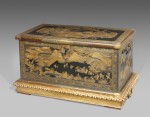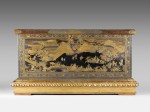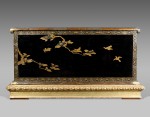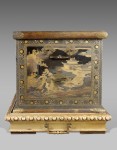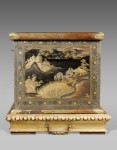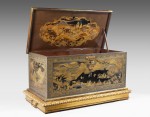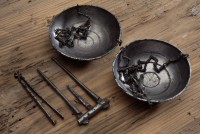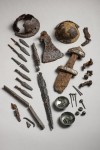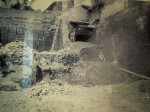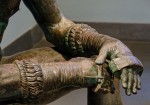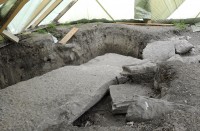 Restorers working on the oldest Jewish cemetery in Vienna have unearthed 20 headstones dating as far back as the 16th century that were carefully buried in 1943 to keep them from being destroyed. The gravestones were buried horizontally in several layers with soil in between. Radar analysis of the grounds indicates there are hundreds of headstones buried on the site. Raimund Fastenbauer of the Israelitische Kultusgemeinde Wien (IKG) (Vienna Israelite Community) believes there may be as many as 600, which, if they could be recovered and restored, would make this little cemetery in the courtyard of a city-run old people’s home a cultural and historical site of great significance, comparable with that of the vast Old Jewish Cemetery in Prague.
Restorers working on the oldest Jewish cemetery in Vienna have unearthed 20 headstones dating as far back as the 16th century that were carefully buried in 1943 to keep them from being destroyed. The gravestones were buried horizontally in several layers with soil in between. Radar analysis of the grounds indicates there are hundreds of headstones buried on the site. Raimund Fastenbauer of the Israelitische Kultusgemeinde Wien (IKG) (Vienna Israelite Community) believes there may be as many as 600, which, if they could be recovered and restored, would make this little cemetery in the courtyard of a city-run old people’s home a cultural and historical site of great significance, comparable with that of the vast Old Jewish Cemetery in Prague.
The Vienna cemetery was founded in 1540 as the main burial ground for Vienna’s Jews. It has no official name but is sometimes referred to today as Seegasse Jewish Cemetery because it’s on Seegasse, or Lake Lane. The cemetery was in use until 1783 when Holy Roman Emperor Joseph II ordered that all burials at cemeteries within city walls cease. New ones were built outside the city while the ones in town were closed and built over. In keeping with Jewish religious requirements, the little cemetery was left alone. No graves were removed, no bodies exhumed, no construction done on the site.
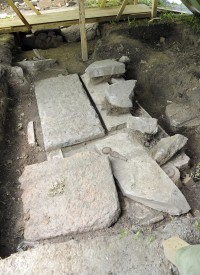 By 1938, Joseph II’s enlightened despotism and relative religious tolerance was but a faint memory. With the Anschluss, the German annexation of Austria, came constant government-approved vandalism and destruction of Jewish property, including desecration of the old cemetery. Many of the 931 historic headstones were damaged or destroyed, but that wasn’t good enough for the Nazis. In 1943, the Nazi government decided to raze the entire cemetery and build over the grounds. The small number of Jews remaining in Vienna braved great danger to save what they could before the bulldozers leveled their ancestral graves.
By 1938, Joseph II’s enlightened despotism and relative religious tolerance was but a faint memory. With the Anschluss, the German annexation of Austria, came constant government-approved vandalism and destruction of Jewish property, including desecration of the old cemetery. Many of the 931 historic headstones were damaged or destroyed, but that wasn’t good enough for the Nazis. In 1943, the Nazi government decided to raze the entire cemetery and build over the grounds. The small number of Jews remaining in Vienna braved great danger to save what they could before the bulldozers leveled their ancestral graves.
Out of the 185,000 Jews living in Vienna before the Anschluss, 65,000 were sent to the death camps from which only 2,000 returned alive. The rest either fled or were killed, leaving 25,000 Jews in Vienna by 1946. Most of them emigrated. Nobody who knew of the fate of the Seegasse gravestones survived, or if they did, revealing the hidden locations was not foremost on their minds.
In the 1980s, some of the gravestones were recovered. They had been removed to Vienna’s Central Cemetery, an interdenominational cemetery built in 1874 with two large Jewish sections, and buried there. Two hundred and eighty of the Seegasse headstones were found during this excavation at Central Cemetery. They were returned to Lake Lane and placed in their original positions using a survey of the site made in the 1910s by Jewish historian and librarian Bernhard Wachstein as a reference. The cemetery was officially re-sanctified on September 2, 1984.
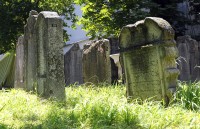 In 2004, the city of Vienna and the government of Austria began a major project of renovation of the Seegasse cemetery. Dozens of headstones have already been restored and work will continue through 2018. If Fastenbauer is right that the 600 or so headstones still missing are buried on the grounds, and if they can be excavated and put back in the original locations as per the Wachstein survey, Seegasse would be the only Jewish cemetery in the world to have been restored to a pre-World War II state.
In 2004, the city of Vienna and the government of Austria began a major project of renovation of the Seegasse cemetery. Dozens of headstones have already been restored and work will continue through 2018. If Fastenbauer is right that the 600 or so headstones still missing are buried on the grounds, and if they can be excavated and put back in the original locations as per the Wachstein survey, Seegasse would be the only Jewish cemetery in the world to have been restored to a pre-World War II state.
